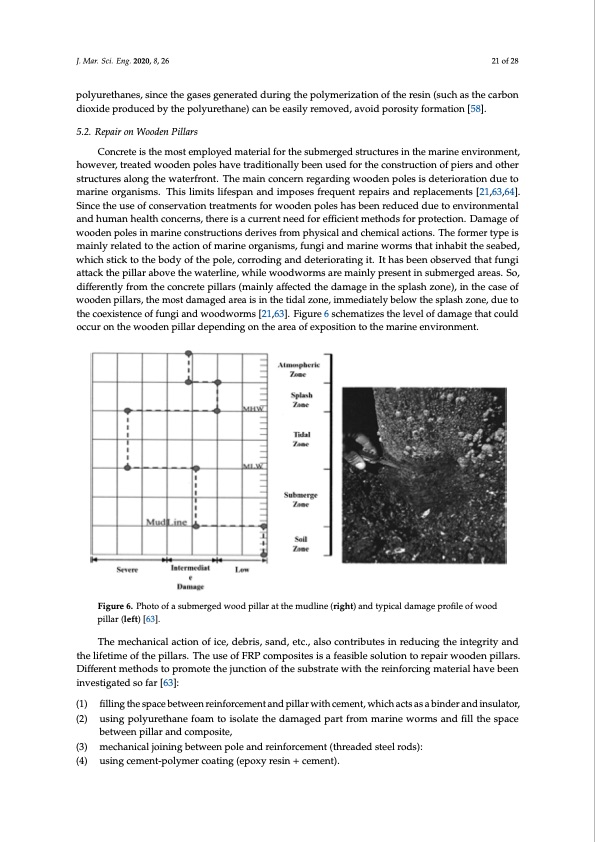
PDF Publication Title:
Text from PDF Page: 021
J. Mar. Sci. Eng. 2020, 8, x FOR PEER REVIEW 21 of 28 J. Mar. Sci. Eng. 2020, 8, 26 21 of 28 polyurethanes, since the gases generated during the polymerization of the resin (such as the carbon dioxide produced by the polyurethane) can be easily removed, avoid porosity formation [58]. polyurethanes, since the gases generated during the polymerization of the resin (such as the carbon dioxide produced by the polyurethane) can be easily removed, avoid porosity formation [58]. 5.2. Repair on Wooden Pillars 5.2. Repair on Wooden Pillars Concrete is the most employed material for the submerged structures in the marine environment, however, treated wooden poles have traditionally been used for the construction of Concrete is the most employed material for the submerged structures in the marine environment, piers and other structures along the waterfront. The main concern regarding wooden poles is however, treated wooden poles have traditionally been used for the construction of piers and other deterioration due to marine organisms. This limits lifespan and imposes frequent repairs and structures along the waterfront. The main concern regarding wooden poles is deterioration due to replacements [21,63,64]. Since the use of conservation treatments for wooden poles has been reduced marine organisms. This limits lifespan and imposes frequent repairs and replacements [21,63,64]. due to environmental and human health concerns, there is a current need for efficient methods for Since the use of conservation treatments for wooden poles has been reduced due to environmental protection. Damage of wooden poles in marine constructions derives from physical and chemical and human health concerns, there is a current need for efficient methods for protection. Damage of actions. The former type is mainly related to the action of marine organisms, fungi and marine worms wooden poles in marine constructions derives from physical and chemical actions. The former type is that inhabit the seabed, which stick to the body of the pole, corroding and deteriorating it. It has been mainly related to the action of marine organisms, fungi and marine worms that inhabit the seabed, observed that fungi attack the pillar above the waterline, while woodworms are mainly present in which stick to the body of the pole, corroding and deteriorating it. It has been observed that fungi submerged areas. So, differently from the concrete pillars (mainly affected the damage in the splash attack the pillar above the waterline, while woodworms are mainly present in submerged areas. So, zone), in the case of wooden pillars, the most damaged area is in the tidal zone, immediately below differently from the concrete pillars (mainly affected the damage in the splash zone), in the case of the splash zone, due to the coexistence of fungi and woodworms [21,63]. Figure 6 schematizes the wooden pillars, the most damaged area is in the tidal zone, immediately below the splash zone, due to level of damage that could occur on the wooden pillar depending on the area of exposition to the the coexistence of fungi and woodworms [21,63]. Figure 6 schematizes the level of damage that could marine environment. occur on the wooden pillar depending on the area of exposition to the marine environment. (1) filling the space between reinforcement and pillar with cement, which acts as a binder and insulator, (1) filling the space between reinforcement and pillar with cement, which acts as a binder and (2) using polyurethane foam to isolate the damaged part from marine worms and fill the space (2) using polyurethane foam to isolate the damaged part from marine worms and fill the space (3) mechanical joining between pole and reinforcement (threaded steel rods): (4) (3) using cement-polymer coating (epoxy resin + cement). mechanical joining between pole and reinforcement (threaded steel rods): Figure 6. Photo of a submerged wood pillar at the mudline (right) and typical damage profile of wood Figure 6. Photo of a submerged wood pillar at the mudline (right) and typical damage profile of wood pillar (left) [63]. pillar (left) [63]. The mechanical action of ice, debris, sand, etc., also contributes in reducing the integrity and the liTfehteimeeochf athneicpaillalacrtiso. nTohfeiuces,edoefbFriRsP, scaonmd,peotcs.i,teaslsios caofnetarsibibulteesoinlurteiodnuctoinrgepthaeirinwteogorditeynapnidllathrse. Dlifieffteimreentomftehtheopdisllatorsp.rTohmeoutesethoefjFuRncPticoonmopfothsietessubisstarafteaswibitlhetshoelurteiionfotrocirnegpamiratweroiaoldhenavpeiblleaersn. iDnivfefesrteignattemdesthoofdars [t6o3p]:romote the junction of the substrate with the reinforcing material have been investigated so far [63]: insulator, between pillar and composite, between pillar and composite,PDF Image | Marine Application of Fiber Reinforced Composites

PDF Search Title:
Marine Application of Fiber Reinforced CompositesOriginal File Name Searched:
jmse-08-00026.pdfDIY PDF Search: Google It | Yahoo | Bing
Development of a solar powered Electric Ship The Electricship website originally started off as a project to develop a comprehensive renewable, affordable, modular electric ship... More Info
Modular Boat Hull Composite The case for a unsinkable, modular composite hybrid boat hull... More Info
MS Burgenstock Hybrid Electric Catamaran Lake Lucerne Unique shuttle servicing Lucerne to the Burgenstock Resort... More Info
Ground Power Unit GPU Powered by Lithium Ion Batteries The goal of the Ground Power Unit is to provide a readily accessible, modular, ready-to-power solution for remote power... More Info
| CONTACT TEL: 608-238-6001 Email: greg@electricship.com | RSS | AMP |